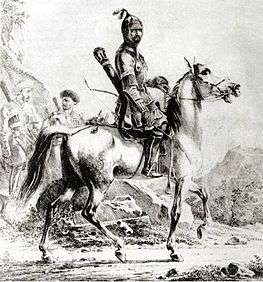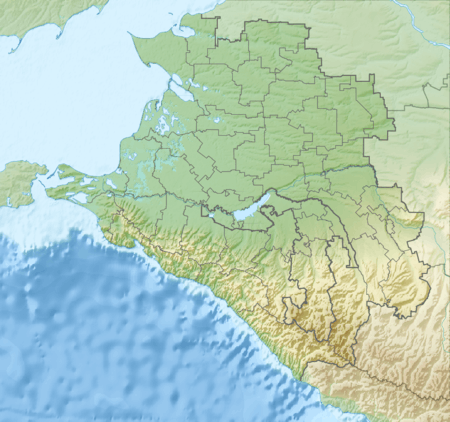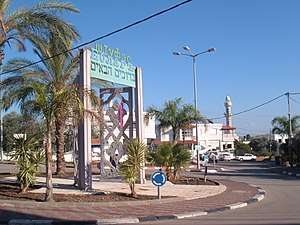Shapsugs
The Shapsug (Adyghe: шапсыгъ [ʃaːpsəʁ], Russian: шапсуги, Turkish: Şapsığlar, Arabic: الشابسوغ, Hebrew: שפסוגים), also known as the Shapsugh or "Shapsogh," are one of the twelve tribes of the Circassian people. Historically, the Shapsug tribe used to make up one of the biggest groups of the Black Sea Adyghe (Причерноморские адыги). They inhabited the region between the Dzhubga (in Adyghe: Жьыбгъэ means "Winds" or "The Valley of Winds") River and Shakhe Rivers (the so-called Maly Shapsug, or Little Shapsug) and high-altitude mountainous areas of the northern slopes of the Caucasus range along the Antkhir, Abin, Afips, Bakan, Ships, and other rivers (Bolshoy Shapsug, or Greater Shapsug). In Russia, the remaining Shapsug population mainly live in the Tuapsinsky District (Tuapse) of Krasnodar Krai, Lazarevsky City District of Sochi, and in the Republic of Adygea (mainly in District of Takhtamukaysky and District of Teuchezksky), which were a small part of historical Circassia.
Шапсыгъ | |
|---|---|
 | |
| Regions with significant populations | |
| 800,000 (approximation) | |
| 4,000 | |
| 3,882[2] |
| Languages | |
| Circassian language West Adyghe dialect Shapsug sub-dialect, Hakuchi sub-dialect, Russian, Turkish and Arabic | |
| Religion | |
| Predominately: Sunni Islam [3] | |
| Related ethnic groups | |
| Other Circassian tribes | |

However, today the major Shapsug communities are found in Turkey, Israel (Kfar Kama), Jordan (Amman, Na'our, Marj Al-Hamam, Wadi Al-Seer), Iraq, Syria, Western Europe, and the United States of America. The first Circassians to settle in Amman were from the Shapsug tribe, and as a result the Shapsug's neighbourhood is considered the oldest neighbourhood in the Capital Amman and was the down town of it;[4] however, other Circassians from the Kabardian, Abadzekh, and Bzhedug tribes also settled in Amman afterwards. Today, the Shapsug are the third-most numerous Circassian tribe in the world, after the most numerous Kabardian and second-most numerous Abzakh tribes. The Shapsug are the most numerous Circassian tribe in Israel, third-most numerous in Turkey where the majority of them live, and the fifth-most numerous one in Russia. In Jordan, after the Abzakh, the Shapsug and Kabardian tribes are the most numerous Adyghe tribes.
The Shapsug speak a sub-dialect of the Adyghe language.[5] According to some indirect data, there were over four thousand Shapsug in Russia in 1926, but the Shapsug people were not enumerated as a separate group in Russian Censuses until 2002, when the population was recorded at 3,231. The Shapsug who live in the Adyghe Republic were enumerated as an Adyghe in general instead of Shapsug in particular, as they are an Adyghe (Circassian) tribe, rather than a separate ethnic group.
In District of Takhtamukaysky a reservoir which was built in 1952 was named after the Shapsug tribe (Russian: Шапсугское водохранилище) since the area was inhabited by this tribe for thousands of years and was considered to be part of historical Shapsugia, a region in historical Circassia.
History

The Shapsug were a very large tribe that occupied extensive territories of Black Sea coast and Kuban River. Different sources note that before the Caucasian war the number of Shapsug people was ranging from 150,000 to 300,000 people. The Shapsug had divisions of Big and Small Shapsug land, the latter being very close to the Natukhai tribe's land. The Shapsug took very active part in the Caucasian war. They had a reputation of invincible people and were one of the last to lay down their weapons under the pressure of tsarist troops in 1864. Some of Shapsug troops fought up to 1880s. After the end of the war the overwhelming majority of the Shapsug were forcefully evicted to Turkey and elsewhere in the Middle East. No more than 6,000 Shapsug people remained on their native land. Nowadays, they live on the territory of Krasnodarsky Krai and make about 20 villages. From 1924 to 1945, there was a Shapsug National District which was abolished during the time of repressions.
Historically the Shapsug controlled the ports of Dzhubga (Adyghe: Жьыбгъэ) and Tuapse to mountain Gorges, and they consisted of 5 aristocratic families and 81 (Adyghe: Фэкъул1) free clans, and were classified as one of the tree democratic Adyghe tribes,[6][7] and were known to have supported the other Adyghe tribes in their struggle against the Crimean Khanate. During the Caucasian War, they were one of the most stubborn enemies of Imperial Russia, joining Shamil's alliance (which would last until 1859). In late 1860, a council was assembled by the representatives of three Adyghe tribes (Shapsug, Ubykh, and Natukhai). The council considered (Adyghe: Шъачэ) Sochi to be the last capital of the Circassian resistance. In 1864, a major part of the Shapsug and other Adyghe tribes moved to the Ottoman Empire due to the Russian army occupation of the region (Circassia),[8] as a result of the tsars' regular policy to cleanse the Circassian coast from Circassians (mainly physically then by expelling the remaining population to the Ottoman Empire.[9] After the end of the Caucasian War (during the period of 1864 to 1870) a major part of the Shapsug, who lived on the territory of Shapsugia, were either killed in the Circassian genocide or expelled to the Ottoman Empire. Some 3,000 Shapsug remained on the Circassian coast.[10]
The Shapsug as an Adyghe tribe always appreciate and honor their immortals (heroes and fighters) who sacrifice their selves to keep Circassia independent in the battles and war with the Russian Empire during the Circassians resistance; by elegies such as the Elegy of the Shapsugs (Adyghe: Шапсыгъэ л1ыхъужъхэм ягъыбз)[11]
Shapsugsky National District
On 6 September 1924, the Bolsheviks established the Shapsug National Raion (Adyghe: Шапсыгъэ Националнэ Район Šapsyġe Nacionalne Rajon, Russian: Шапсугский национальный район Šapsugskij nacional′nyj rajon) as a part of the Black Sea Okrug. The district contained around 3,400 Shapsug people, and the center of the district was the coastal city of Tuapse. In the beginning of 1925, it was divided into 4 village councils: Karpovsky, Kichmai, Krasno-Aleksandrovsky, and Pseushkho. After the end of the Second World War in 1945, the Shapsug National Raion was renamed Lazarevsky District.
In 1990, the first congress of the Shapsug tribe took place, where they would adopt a declaration on the reinstatement of the Shapsug National Raion. On 12 June 1992, the Presidium of the Supreme Soviet of the Russian Federation passed a resolution on the establishment of the Shapsug National Raion.
Culture
The traditional Shapsug culture had much in common with other Circassian tribes. The Shapsug were engaged in agriculture, cattle and horse breeding, gardening, viticulture, and beekeeping. In pre-Islamic and pre-Christian times, the Shapsug worshiped the Circassian gods—Shible (god of thunder and lightning), Sozeresh (Adyghe: Созереш) (god of fertility), Yemish or Yemij (god of war), Akhin and Khakustash (protectors of cattle breeding), Tlepsh (god of blacksmithing), Keshkogwasha (Adyghe: Хышхогуащэ) (god of the Black Sea), etc. The Shapsug used to perform the Hantse Guashe (Adyghe: Хьэнцэ гуащэ) ceremony of rain calling during droughts by carrying a dressed doll through the aul and then drowning it in the river, and never getting it out before raining.[12]
Since the early 19th century, the Shapsug are primarily Sunni Muslims (Hanafi).[13]
Language
The Shapsug (Adyghe: Шапсыгъэбзэ) is one of the mutually intelligible sub-dialects of the Adyghe language's West Adyghe dialect.[14] There were two major varieties of Shapsug before the exile of the Circassians. Since the Shapsug scattered around the world, each Shapsug community developed a different form of speech.
Some Shapsug families
| Circassian | Transcription | Circassian | Transcription | Circassian | Transcription | Circassian | Transcription | Circassian | Transcription | Circassian | Transcription |
|---|---|---|---|---|---|---|---|---|---|---|---|
| Натхъомэ ялIакъохэр | Natkhoma Yalhakhokhar | НэтIахъомэ ялIакъохэр | Natkhoma Yalhakhokhar | Коблы ялIакъохэр | Kobl Yalhakhokhar | Шъхьаптэхэ ялIакъохэр | Shhaptakha Yalhakhokhar | Гъуагъо-Шъэотэхмэ ялIакъохэр | Ghorha-shawatkhma Yalhakhokhar | Гуаемэ ялIакъохэр | Guayama Yalhakhokhar |
| Акьэжъ | Achazh | Абир (Абыр) | Abir | Ачъумыжъ | Achmuzh | Абрэгь | Abreg | БжьашIо | Bzhasho | БжыхьалI | Bzhihalh |
| Ачъокъу | Achoq | Алащэ | Alasha | Бастэ | Basta | Егъум | Yagum | Борэкъо | Boraqo | Гунай | Gunai |
| Багьэ | Baga | Бэус | Baws | Батэ | Bata | Нэгъучъу | Naghuchu | Гусэр | Gusar | Дачъэ | Dacha |
| Бзыщ | Bzish | Гъурыжъ | Ghurezh | Бгъанэ | Bghana | ОгъулI | Waghulh | Джадэ | Jada | ЕкIуашъ | Yaquash |
| Быркьэ | Berka | Дыжьы | Dizh | Джарым | Jarem | Пцашэ | Ptsasha | Иныхъу | Yinikho | КIэсэбэжъ | Chasabazh |
| БэгъэгушIу | Baghagushu | Дэджэраджэ | Dajaraja | Дэбэхьу | Dabahu | Тыркуао | Tirquawa | Къанщэжь | Qanshazh | Къэрэджан | Qarajam |
| Джарым | Jarem | Ешъуталъэ | Yashutalha | Дэгуф | Daguf | Хъуд | Khud | Къуаджэ | Quaja | ЛIыхъужъ | Lhekhuzh |
| Емызагъ | Yamezagh | КIакIыхъу | Chachekhu | ЛIыф | Lhif | ХыдзэлI | Khidzalh | ЛIыхъужъыкъу | Lhekhuzhequ | Лъэцэрыкъу | Lhatsariqu |
| Ергъужъ | Yarghuzh | МэзакIу | Mazaku | ЛIыхъужъ | Lhekhuzh | Хьагъур | Haghur | Лъэпшъыкъу | Lhapshiqu | Мэджаджэкъу | Majajaqu |
| КIуф | Kuf | Пэхъу | Pakhu | Наго | Nago | Хьахъу | Hakhu | Мышъэ | Misha | Мэмэт | Mamat |
| Кьэхъу | Kakhu | Тхыжъ | Tkhizh | Нащэ | Nasha | Хьэлъакъу | Halhaqu | Мэт | Met | Мэт | Met |
| ЛIыкьас | Lhikas | Хьазыкъу | Haziqu | Нэгъужъ | Naghuzh | Шъау | Shaw | ПсэкIэкI | Psachach | Нэукъ | Nawq |
| Мэлыщ | Malish | Хьахъуратэ | Hakhurata | Нэпсэу | Napso | Шъхьэлахъо | Shhalakho | Тым | Tim | ПщыукI | Pshiwch |
| Мэфэуд | Mafawud | Хьурым | Hurim | Псэукъо | Psoqo | Ушъый | Wshiy | Сабын (Сабыныкъу) | Sabeniqu) | ||
| Натхъо | Natkho | ШIужъэкъу | Shuzhaqu | Пэкожъ | Pakozh | Хъун | Khun | ТхьалI | Thalh | ||
| НэмылIэкъу | Namilhaqu | Шъуагьэ | Shuaga | РатIэкъу | Rataqu | Хьатыщ | Hatish | Хьагъун | Haghun | ||
| Отэхь | Watah | Шъхьабэ | Shhaba (originally Ubykh) | ТIэшъу | Tashu | Чъушъхьэ | Choshha | ХьамтIэхъу | Hamtakhu | ||
| Сэхъут | Sakhut | ШъхьакIумыдэ | Shhakumida | Тамухъ | Tamukh | ШIуцIэ | Shutsa | ||||
| Тхьэкъуахъо | Thaquakho | Тхьакъуахъо | Thaquakho | Шъэгьашъ | Shagash | ||||||
| Тыкъо | Tiqo | Тыу | Tiw | Шъэотэхьу | Shawatahu | ||||||
| Тыу | Tiw | Хъупщ | Khupsh | Шыу | Shiw | ||||||
| Хьапый | Hapiy | ХъутIыжъ | Khutezh | ШэкIолI | Shakolh | ||||||
| Хьатх | Hatkh | ХьамтIыжъ (ХьамтIэ) | Hamtizh | ||||||||
| Хьатыу | Hatuw | Хьантыу | Hantuw | ||||||||
| Шыумыжъ | Shiwmizh | Хьаратэ | Harata | ||||||||
| ШэхэлI | Shakhalh | Хьэтаужъ | Hatawzh | ||||||||
| чемсо | Chemso | ШъэIужъу | Shauzhu | ||||||||
| Шъэумэн | Shawman | ||||||||||
| ШэрэлI | Sharalh | ||||||||||
| Шэугьэн | Shogan | ||||||||||
Some of the Shapsug families in Jordan
- Kosho (Adyghe: Кушъу / Кушу)
- Pshedatok (Adyghe: Пшыдатукъ)
- Shhalakhwa (Adyghe: Шхьэлахъо)
- Psekenop (Adyghe: Псыкынуп)
- Jan (Adyghe: Джан)
- T’harkakhwa (Adyghe: Тхьэркъахъуэ)
- Kwiej (Adyghe: Къуеж)
- Hadagha (Adyghe: Хьэдагъэ)
- Meesha (Adyghe: Мишэ)
- Hatough (Adyghe: Хьэтогъ)
- Naghoj (Adyghe: Нэгъуж)
- Tamokh (Adyghe: Тамохъ)
- Khorma (Adyghe: Хъурмэ)
- Bghana (Adyghe: Бгъанэ) which changed in Jordan to Hakouz (Adyghe: Хэкужъ after their 15th great-grandfather Хэкужъ born in 1337 in Tuapse, and this family considered the biggest Shapsug family in Jordan.
- Natkho (Shukri) (Adyghe: Натхъо)
- Shawash (Adyghe: ШъэошIу)
- Shoupash (Adyghe: Шупащ)
Shapsug families in Kfar Kama, Israel
- Abrag (Adyghe: Абрэгь)
- Ashmuz/Achmuzh (Adyghe: Ачъумыжъ)
- Bghana (Adyghe: Бгъанэ known as Hakouz -Хэкужъ -in Jordan after their 15th great grandfather)
- Bat (Adyghe: Бат)
- Blanghaps (Adyghe: БлэнгъэпсI)
- Batwash (Adyghe: БэтIыуашъ)
- Zazi (Adyghe: Зази)
- Kobla (Adyghe: Коблэ)
- Qal (Adyghe: Къалыкъу)
- Qatizh (Adyghe: Къэтыжъ)
- Lauz (Adyghe: ЛъыIужъ)
- Libai/Labai (Adyghe: ЛIыпый)
- Nago (Adyghe: Наго)
- Natkho (Adyghe: Натхъо)
- Nash (Adyghe: Наш)
- Napso (Adyghe: Нэпсэу)
- Thawcho (Adyghe: Тхьэухъо)
- Gorkhezh (Adyghe: ГъоркIожъ)
- Hazal (Adyghe: Хъэзэл)
- Hadish (Adyghe: Хьэдищ)
- Hako/Hakho (Adyghe: Хьэхъу)
- Shamsi (Adyghe: Чъомшъо)
- Choshha/Shoshha (Adyghe: Чъушъхьэ)
- Showgan (Adyghe: Шэугьэн)
- Shaga (Adyghe: Шъуагьэ)
- Sagas/Shagash (Adyghe: Шъэгьашъ)
In the past there was also Shhalakhwa (Adyghe: Шхьэлахъо) and Kuadzhe (Adyghe: Къуаджэ).
Notable people
- Tirimüjgan Kadın – Mother of Sultan Abdul Hamid II of the Ottoman Empire
- Karzeg Sait Bey (1887–1920)
- Çerkes Ethem
- Hazret Sovmen
- Tuguzhuko Kyzbech
- Suna Öz – Mother of Dr Oz
- Bibras Natkho
- Nili Natkho
See also
References
- Russian Federation Federal State Statistics Service (FSSS) (2010). Всероссийская перепись 2010, Материалы. Табл. 7. Национальный состав населения по субъектам Российской Федерации [All-Russian Census 2010, Materials. Table 7. National Composition of the Populations on the Subjects of the Russian Federation] (Press release) (in Russian). Moscow.
- Официальный сайт Всероссийской переписи населения 2010 года. Информационные материалы об окончательных итогах Всероссийской переписи населения 2010 года (in Russian)
- https://www.refworld.org/docid/558bc7514.html
- "Archived copy". Archived from the original on 2015-10-02. Retrieved 2015-09-22.CS1 maint: archived copy as title (link) Official Website of Amman
- "Archived copy". Archived from the original on 2010-12-28. Retrieved 2010-10-26.CS1 maint: archived copy as title (link) Shapsug Sub-Dialect (French Language)
- Walter Richmond , The Northwest Caucasus: Past, Present, Future, p. 22, Central Asian Studies Series, 2008 ISBN 978-0-415-77615-8
- Walter Richmond, "The Northwest Caucasus: Past Present, Future", Arabic Translation by Jameel Ishaqat, p. 46, Circassians Studies Centre, Amman, Jordan, 2010
- http://english.ruvr.ru/2010/07/05/11511062.html via the Voice of Russia
- Peter Hopkirk The great game: On Secret Service in High Asia, Chapter 12 "The Greatest Fortress in the World", pp 158–159, Oxford University Press, 2001 ISBN 0-19-280232-1
- http://rt.com/Top_News/2010-06-05/sochi-adyg-culture-olympics.html by Russia Today (English)
- "Адыгэ 1оры1уатэм ухэзгъэгъозэн тхылъ", Ехъул1э Ат1ыф, Нахэ (176), гощын (2), Адыгэ ш1уш1э Хасэ, Йордания, 2009. (Circassian language)
- "Адыгэ 1оры1уатэм ухэзгъэгъозэн тхылъ", Ехъул1э Ат1ыф, Нахэ (91), гощын (2), Адыгэ ш1уш1э Хасэ, Йордания, 2009 (Circassian Language)
- "The Last Defenders of the Prophet". New York Times. 21 June 1877.
- Shapsug sub-dialect Archived 2010-12-28 at the Wayback Machine (in French)
External links
- Official site of Shapsugia (Russian/Adyghe)
- Famous Circassians
- Journal of a residence in Circassia during the years 1837, 1838, and 1839 - Bell, James Stanislaus (English)
